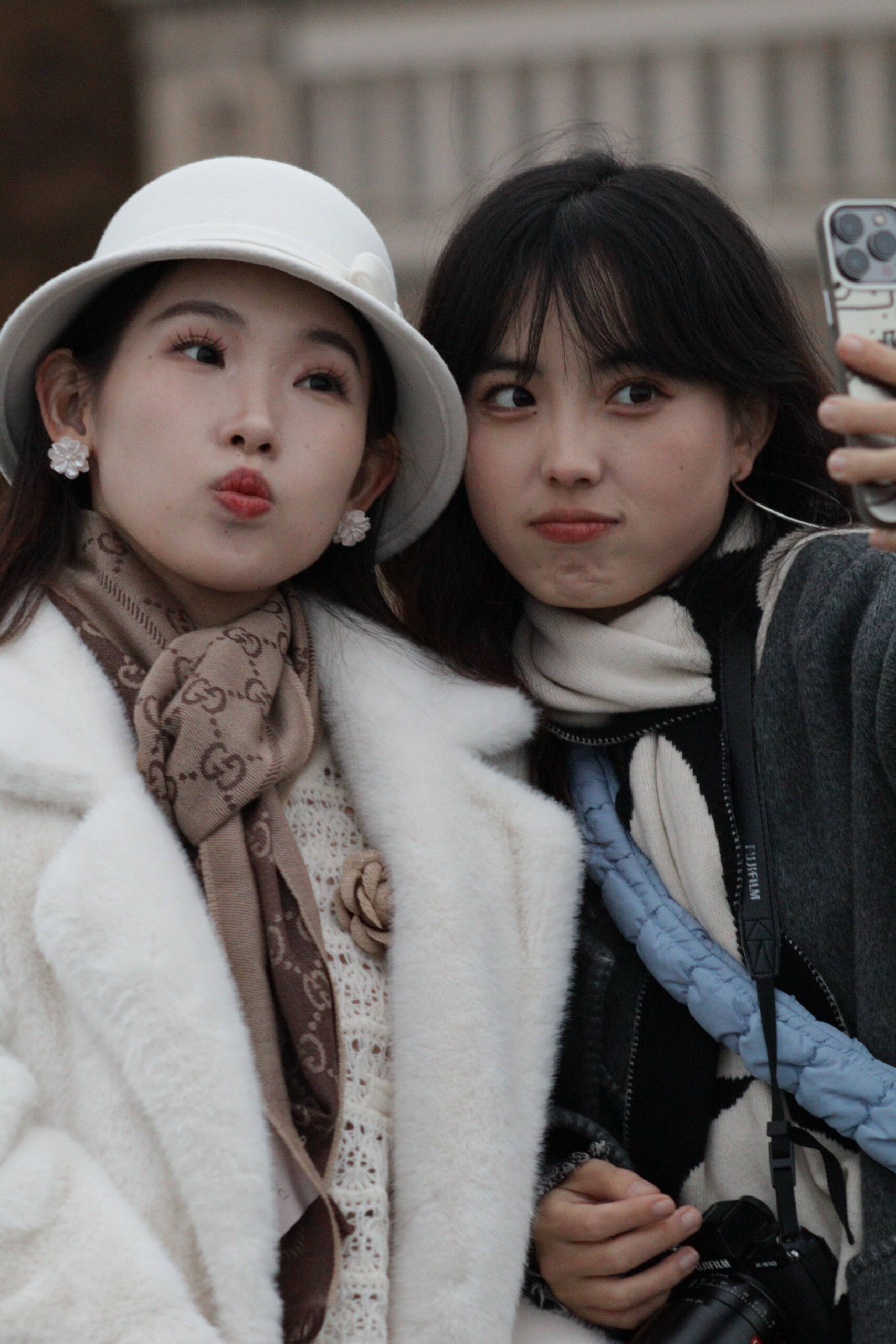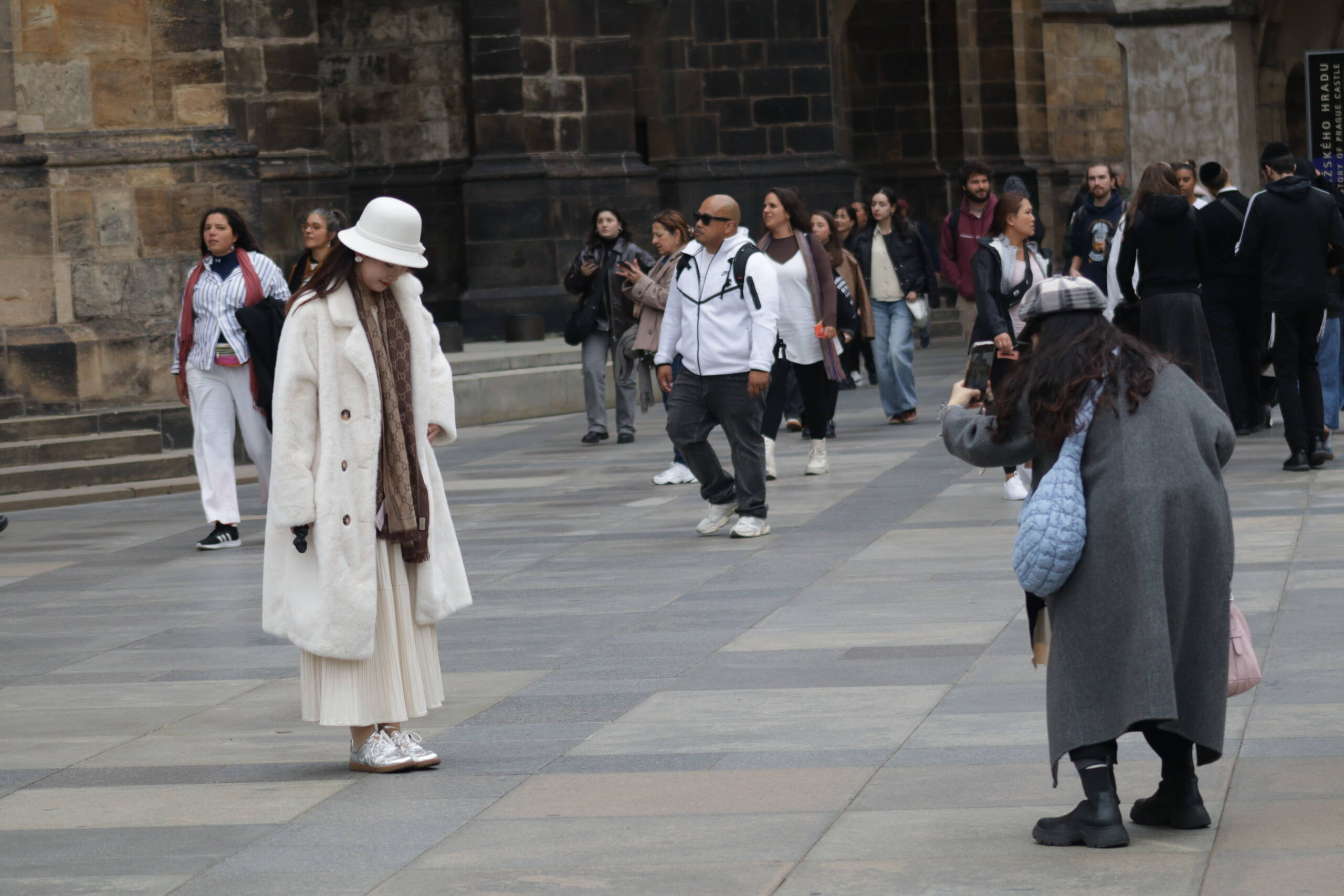There are certain travel moments that feel staged, but so well staged that you almost want to forgive them for it. The photo I stumbled across of two friends posing together in what I can only describe as a very “Emily in Paris” fashion has stuck with me for hours. There’s something magnetic in the way these two present themselves, and the deeper you look, the more layers unfold—fashion choices that double as brand promotions, tools of documentation that reveal an entire influencer strategy, and above all, a quirky friendship dynamic that has turned the art of traveling in pairs into its own kind of performance.

At first glance, it looks like nothing more than a touristy selfie. One friend stretches out her arm with an iPhone, lips puckered into a theatrical pout. The other leans in with a sly smirk, as if half-laughing at the whole situation. But then you notice the details that betray the influencer DNA. The crisp white coat that seems to have been chosen less for warmth and more for photographic contrast against the winter background. The matching hat, perched at just the right angle. The Gucci scarf, draped not for comfort but for visibility, its logo placed like a signature in the corner of a canvas. Oversized floral earrings catch a glint of light, and a carefully pinned brooch sits perfectly aligned, not an inch out of place. This isn’t accidental; this is styling.
The second friend provides a foil in darker, muted tones: a charcoal jacket, a bulky scarf, a pastel-blue strap that slices diagonally across her torso in a line that adds texture to the whole composition. Together they look like opposites written into the same script—one luminous, one grounded, yin and yang rendered in streetwear. This contrast is not just visually pleasing but practical: it allows followers to identify with one or the other, to pick their muse. It’s a clever bit of unspoken branding, whether they intended it that way or not.
But what makes this scene truly fascinating isn’t just the clothes. It’s the tools they carry. In the raised hand of the white-clad friend is an iPhone Pro. The telltale triple-lens camera array on the back makes it instantly recognizable, the kind of device that has become synonymous with influencer culture. The iPhone is not just a phone anymore; it is the Swiss Army knife of the digital age—camera, editor, broadcaster, and store-front all in one. With it, they can capture a photo, throw on a filter, tag Gucci and Chanel Beauty, add a cheeky caption, and have it up on Instagram Stories within two minutes. This is the instrument of immediacy, and the way it’s wielded—casually, confidently, as though the selfie and the post are one single gesture—shows how deeply embedded it is in their practice.
Hanging across the other friend’s shoulder, however, is a different kind of tool: a Fujifilm camera. The strap makes it obvious, the branding not hidden but proudly displayed. Fujifilm’s X-series mirrorless cameras have become the darlings of the influencer and traveler crowd for good reason. They’re light, retro-styled, and their film simulations add a dreamy, cinematic quality that smartphones, for all their computational magic, still can’t quite replicate. From the look of its size and shape, I’d guess it’s an X-T30 or maybe the X-S10—both models that blend portability with professional-level image quality.
The duality here is telling. The iPhone is for speed, for ephemerality, for keeping the algorithm fed in real time. The Fuji is for artistry, for content that takes hours to edit and which drops later as the “highlight reel.” One is fast fashion, the other is haute couture. One is McDonald’s, the other is fine dining. The fact that they carry both says everything: nothing will go undocumented, and every moment has two versions, two lives—one immediate and fleeting, the other polished and permanent.
It would be easy to dismiss the clothing choices as simply “stylish tourists,” but I’d argue they’re far more than that. Look again at the white outfit. The Gucci scarf isn’t wrapped tightly for warmth; it’s draped so the brand is visible. The lipstick, a bold red, isn’t just makeup—it’s a statement color, chosen because it pops on camera, even in overcast light. The oversized earrings draw the eye upward, framing the face for the selfie. Even the flower-shaped brooch pinned neatly onto the coat’s lapel feels like a branding decision. These are not just clothes and accessories; they are potential product placements, subtle signals for future sponsored posts.
And cosmetics? Equally deliberate. The smooth skin, the carefully sculpted brows, the precise blush—these choices make the selfie post-ready without the need for heavy editing. Followers will see this and wonder, what lipstick shade is that? or how do her cheeks look so fresh even in the cold? That curiosity is monetizable. The influencer economy thrives on such questions, and the answers are often affiliate links or sponsored tags. What begins as a playful selfie ends as a shopping list for someone scrolling at home.
None of this would work quite the same if they were alone. Influencers travel in pairs because pairs create stories. One poses, the other captures, and then they switch. They egg each other on, experiment with expressions, improvise with quirks. The exaggerated pout is funnier because it’s shared; the sly grin is sharper because it’s aimed at a friend. Traveling solo might look lonely, even forced, but traveling with a partner produces a rhythm that feels natural and playful.
It’s also practical. One acts as a photographer when the other is the subject, ensuring that neither ever has to rely on strangers or awkward tripod setups. The workflow is smooth: shoot on the iPhone for immediate Stories, switch to the Fuji for long-form posts. Compare selfies, laugh at bloopers, retake until satisfied. Every city becomes their shared stage, every monument a backdrop, every street corner a runway.
And the quirkiness? That’s the special sauce. The moment you realize they’re not just posing seriously but mocking the seriousness at the same time, the whole thing becomes magnetic. You get the sense they know exactly how influencer-coded they look, but they lean into it with irony. That wink of self-awareness is what keeps followers hooked—it feels authentic even when it’s staged.
When you zoom out, this scene becomes a microcosm of the larger influencer economy. On the surface: two friends on a trip, having fun. Beneath that: a carefully structured content pipeline. The phone feeds immediacy, the camera feeds curation. The clothes feed fashion brands, the cosmetics feed beauty sponsorships. The pair dynamic feeds authenticity. It’s a self-sustaining loop where nothing goes undocumented and nothing is wasted.
Here the whole Emily-style influence travel story suddenly widens into its stage. The photo shows the same white-clad figure, wrapped in her plush coat, matching hat pulled low, Gucci scarf draped neatly, standing as though in quiet contemplation in the middle of a bustling square. She is perfectly posed, not in a loud, exaggerated way, but in a soft editorial stance—the kind of look you’d see in a fashion spread, her head slightly tilted down, the creamy pleats of her skirt brushing against her silver shoes. Around her flows the casual chaos of everyday tourists: people in hoodies, backpacks, practical sneakers, some mid-stride, others snapping their own pictures. And yet, despite the crowd, she seems untouched, almost as if the street has turned into her runway.

The secret of the shot, though, is visible to us: her friend, crouched at a low angle, phone in hand, snapping away. The oversized grey coat, the soft blue quilted bag slung over her shoulder, the practical black boots—all part of her own style but, in this moment, serving a supporting role. She bends into the role of photographer with casual expertise, making sure to frame the scene so her friend looks like the centerpiece of the square, while the rest of the crowd fades into background noise.
This image captures the exact dynamic that defines influencer travel. One plays the muse, styled in white, embodying Emily-style quirkiness—slightly dramatic, slightly whimsical, but always photogenic. The other becomes the documentarian, crouching and framing, ensuring the shot has the right angle, the right balance, the right narrative. Together, they convert a busy tourist site into their personal stage, their photoshoot spilling casually into the stream of ordinary travelers who unknowingly become extras.
It’s Emily-style influence travel in its purest form: one friend as the whimsical heroine, the other as her knowing accomplice, both transforming a simple square into a brandable moment. What looks like a candid pause is in fact a carefully staged act, rehearsed not in words but in gestures, captured across devices, destined for the feed.
It’s also aspirational. Followers don’t just want the coat or the scarf—they want the friendship dynamic, the sense of stylish camaraderie, the idea of traveling the world with someone who complements your aesthetic while documenting every second of it. This is why influencer travel is so effective: it sells not just products, but lifestyles, relationships, and dreams.
There’s something very “Emily in Paris” about the whole performance, but with a twist of irony that makes it even better. The white outfit could easily belong to Emily herself—bright, slightly over-the-top, chosen as much for its Instagram appeal as for practicality. The contrasting friend could be her grounded sidekick, rolling her eyes but secretly enjoying the spectacle. Together they transform a simple street corner into a stage, a selfie into an entire narrative.
And so you’re left with an image that works on multiple levels. It’s quirky and playful, but also layered with intention. It’s stylish, but also commercial. It’s spontaneous, but also staged. It’s two friends having fun, but also two influencers running a joint operation that doubles as brand promotion. It’s an iPhone and a Fujifilm, a Gucci scarf and a bold lipstick, a wink and a smirk.
Leave a Reply